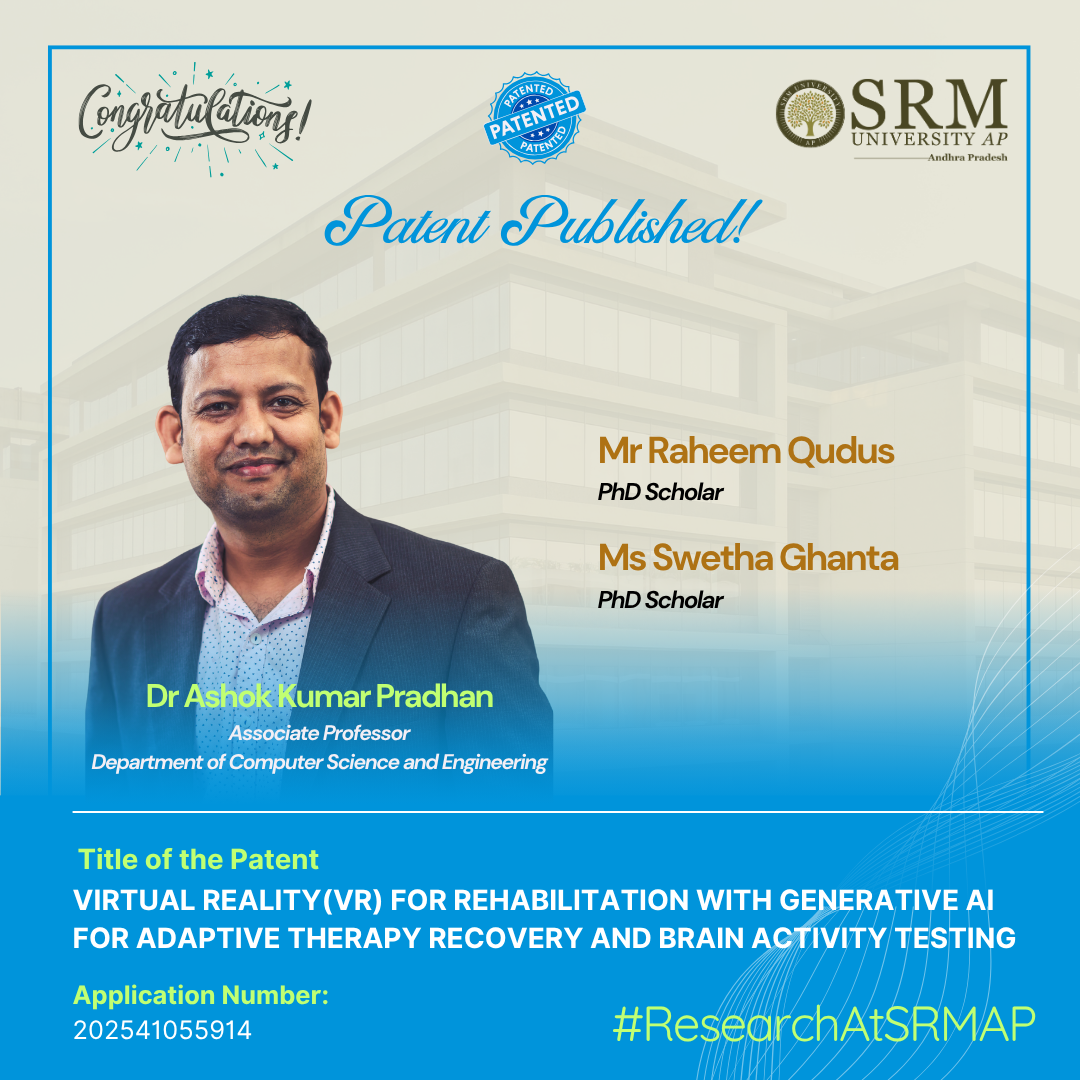 The Department of Computer Science and Engineering at SRM University-AP has yet again produced a scientific breakthrough. Associate Professor Dr Ashok Kumar Pradhan, along with his research scholars Mr Raheem Qudus and Ms Swetha Ghanta, published a patent on post-stroke rehabilitation using Virtual Reality and Artificial Intelligence.
The Department of Computer Science and Engineering at SRM University-AP has yet again produced a scientific breakthrough. Associate Professor Dr Ashok Kumar Pradhan, along with his research scholars Mr Raheem Qudus and Ms Swetha Ghanta, published a patent on post-stroke rehabilitation using Virtual Reality and Artificial Intelligence.
Brief Abstract of the Research
Stroke is one of the most significant health problems that aid disability and mortality in functionality of human health, While already there are varies approach, Traditionally and Technical methods developed to help patient overcome these challenges, common system to treat and help patients recovers from this are, using Local therapy approach, using EEG (electroencephalogram) and or using the BCI (Brain Computer Interface). However, not all patients find this approach applicable, suitable and affordable. The aim of this research is to perform Post-Stroke Rehabilitation recovery training and testing on patient without the need for Brain computer Interface (BCI) and Electroencephalogram (EEG), our proposed method provides similar embodiment and rehabilitation capabilities to those perceived from existing therapeutic techniques such as Constraint induced movement therapy (CIMT), Occupational therapy, mirror therapy and authenticating fear. Our Research approach resolution is to develop a virtual reality (VR) based system for post-stroke rehabilitation using Meta Quest (Headset) and Unity game engine for simulation of the virtual environment. Our emerging methods in integrating Generative-AI to provide adaptive therapy recommendations based on patient movements and engagement levels. While we implement the use of a real-time compensatory movement detection system without EEG, relying on AI-driven motion analysis.
Explanation in layperson’s terms:
After a stroke, patients often struggle to regain movement or perform simple tasks. Existing treatments rely on traditional and invasive signal equipment, such as wearing of electroencephalogram(EEG), and also require a professional expert to track and interpret the progress of the patient, while relying on real-world objects. Our invention solves those existing limitations through the integration of Virtual Reality (VR) and Artificial Intelligence (AI). We create a virtual world and object where stroke patients wear a VR headset and perform exercises in a simulated environment, while patients are able to feel a real-world immersive experience through movement practice, with a real-time communication guide of AI to aid users’ improvement.
Practical Implementation and Social Implications:
- Implementation: Clinics or homes can use our VR system to supplement therapy, reducing costs and therapist workload.
- Social Impact: Makes rehab accessible to low-income patients, avoids the stigma of bulky medical devices, and could reduce global stroke-related disability burdens.
- Accessible Therapy: Makes rehabilitation possible from home, especially in rural areas or underserved communities.
- Personalised Healing: The AI ensures therapy matches the patient’s ability in real time by providing real-time support during the session.
- Mental Health & Cognitive Benefit: Helps with memory, attention, and mood rehabilitation using immersive tasks.
Collaborations:
SRM University-AP, Amaravati (Assignee)
Future Research Plans:
- Expand the discovery into an adaptation framework for elderly care, PTSD treatment, and education for neurodivergent learners.
- Pilot clinical testing with actual stroke patients in collaboration with hospitals.
- Expand the system to support speech therapy and cognitive recovery tools.
- Integrating an AI-Agent for real-time Non-player character medical support during the immersive session.

